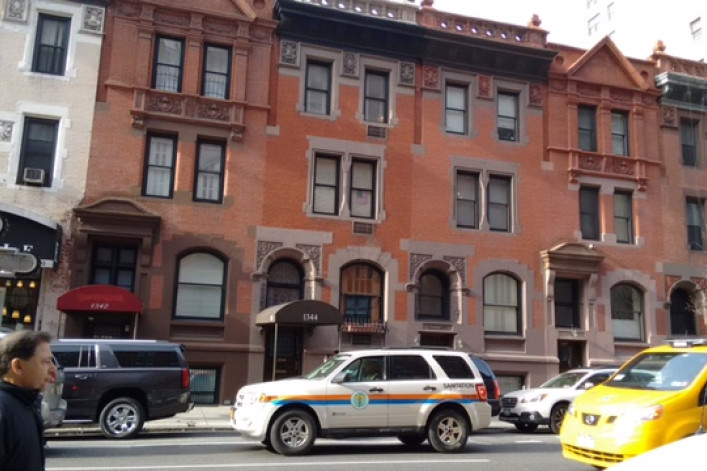The Rhinelander District: A tiny slice of the Upper East Side that Andy Warhol called home

For one of the shortest walking tours ever, we suggest you take a stroll around the tiny Hardenbergh/Rhinelander Historic District on Manhattan's Upper East Side. No walking shoes required.
One of the smallest historic districts in the city, it's just 121 East 89th Street and the six row houses north of the corner of Lexington and 89th. That’s it: Seven homes total. And while it may be small, it’s a good intro to what Yorkville looked like at the end of the 19th century when the area really started to develop.
Here are five things you probably don't know about this stretch of Lexington Avenue:

The district during the 1930s. Credit: Landmarks Preservation Commission.
1. It represents the beginning of a new era uptown.
Before 1832, there was no Lexington Avenue to be developed (or Madison Avenue either for that matter). That was the date that the state legislature voted to make it possible to add the two avenues, according to a Landmarks Commission report.
Lexington Avenue was inserted between what had been Third and Fourth Avenues but didn’t make it up to 89th Street until 1869.
Expanded transportation beginning with a Yorkville stop on the New York and Harlem Railroad in the 1830s, horse car lines (streetcars drawn by horses) running along Second and Third Avenues by the 1850s and ferry service to Astoria from an East River terminal all helped to bring Manhattan life northward and with it, the impetus for developers to start doing what they like best—building housing on spec. That's exactly what the developers of the buildings in this historic district did, according to Landmarks.

1340 and 1342 Lexington today. Credit: Marjorie Cohen
2. The district was built by the Rhinelanders, who were Manhattan real estate “moguls” for more than 200 years.
It all began with William Rhinelander, son of Philip Jacob Rhinelander, a Huguenot of German descent who moved to New York City in the beginning of the 1700s. William used profits from his shipping business to buy a piece of land north of Barclay Street (in what is now the Financial District) and so it began. William’s grandson, William Christopher Rhinelander, wound up managing the substantial Rhinelander family holdings in the mid- 1800s, which by then included 48 acres along the East River in Yorkville. When he died, his four children divided the assets and sold, leased, or developed their pieces.
It was in the 1880s that the Rhinelanders developed their Upper East Side land which, besides the historic district area, also included property on the blocks between 86th to 89th, from First to Second Avenues. The city’s Historic Landmarks Preservation Commission quotes the 1879 Real Estate Record and guide as saying what could as easily be said of 21st century developers: “The Rhinelanders detest an unproductive estate.”
The Rhinelanders were more than just businessmen; they were philanthropists, too, instrumental in the building of the Children's Aid Society’s Rhinelander Industrial School on East 88th Street (the school has recently left the building) and a few doors down from it, the Church of the Holy Trinity Complex.

The name of this Upper East Side condo building pays homage to the Rhinelander family. Credit: StreetEasy
And, the family is still not forgotten on the Upper East Side today. When a building called The Rhinelander at 141 East 88th Street was being converted from a rental to a condo, the developers wanted a name change: ”Rhinelander just doesn’t roll off the tongue, “ explained Jennifer Steig of Cheshire Group to Newsday, which worked on the conversion. But, they didn’t abandon the name altogether. Instead, they chose to call their project Philip House instead, conjuring up the Rhinelander who started it all.
3. The Rhinelanders hired one of the most famous architects of the era to design the row houses. The total bill for his design and for construction for each row house: $9,500.
That’s right. The entire cost of under $10,000 included the services of Henry J. Hardenbergh, who became one of the most famous architects in the city and beyond. How famous was he?
He’s the person who designed the Dakota , the original Waldorf-Astoria Hotel (which was on 34th and Fifth but since demolished), the Plaza Hotel and a number of early rowhouses on the Upper West Side. His fame extended to other cities in the United States—he designed the Copley Plaza Hotel in Boston and the Willard Hotel in Washington, D.C.—and even ventured to Montreal to work on the Hotel Windsor.
4. The building at 121 East 89th was built as a “French Flat,” a term meant to attract a wary middle class.
Before the 1880s, many New Yorkers considered the idea of living in a multiple dwelling absolutely declassé. Writing in 1880, author Sarah Gilman Young explained why: “There being no fixed caste in America as in foreign states, we have established a certain style of living and expenditure as a distinctive mark of social position.” That certain style of living at the time meant owning your own house, not renting in a building shared—heaven forBID—with others.
But, by the time the Rhinelanders commissioned the multiple dwelling unit that is part of the historic district, developers had sweetened the deal by calling these buildings “French Flats,” distinguishing them from tenements and appealing more to the upper middle class.
At the time, the Parisian apartment house was the standard of perfection, so calling the buildings French flats gave them the requisite aura of romance and sophistication.

121 East 89th Street. Credit: StreetEasy
The building at no. 121 (shown above) is an excellent example of the kind of French Flat that was being built at the end of the 19th century. Four stories high, it was originally built with just one unit per floor but has since been divided into many more units. French Flats typically had four to ten rooms, many quite large, and offered the added luxury of baths and toilets. The dignified exterior of the building is built of brownstone and brick with terracotta embellishments, made to blend with the rowhouses around the corner.

The famed artist lived here -- with many cats. Credit: StreetEasy
5. Andy Warhol, his mom and 20 to 25 cats (depending who you ask) lived here.
In 1959, Warhol and his mom moved into 1342 Lexington Avenue, where the artist set up his studio on the ground floor; his mom lived in the basement, near the kitchen, according to the Village Voice. By that year he had made enough money from his career in commercial art to buy his own NYC home. The brownstone is 16.5 feet wide with over 3,000 square feet of living space. It is where Warhol created his Campbell Soup series and silkscreens of Marilyn Monroe; he lived there until 1974 when he decamped for downtown.
 Warhol’s nephew, James Warhola (the artist’s real last name), wrote a charming children’s book about one of his annual visits to his uncle’s home called “Uncle Andy’s." In it he talks about 25 cats that lived there, all named Sam, and includes some great watercolor illustrations of Warhol, his mom, the cats and all of Andy’s “stuff."
Warhol’s nephew, James Warhola (the artist’s real last name), wrote a charming children’s book about one of his annual visits to his uncle’s home called “Uncle Andy’s." In it he talks about 25 cats that lived there, all named Sam, and includes some great watercolor illustrations of Warhol, his mom, the cats and all of Andy’s “stuff."
Two years after Warhol died in 1987, his executor bought the house for $593,000. Fast forward to 2014 when it was listed for $8.75 million, admittedly after some major renovations in 2012 (It appears the house is no longer on the market.)
Another figure in New York history who lived in this historic district was Dr. Albert Decker. Although Decker is nowhere near as famous as Warhol, he has probably directly influenced a lot more lives. Decker opened the Fertility Institute of New York in one of the homes in the District; it was one of the first centers devoted to the diagnosis and treatment of infertility.
Looking to live in one of these buildings yourself? At the moment, nothing is available for sale or rent. (According to StreetEasy, the house at 121 East 89th Street sold for $6.75 million three years ago). We suggest you keep an eye out.
Related:
The history behind Grand Concourse, the "Champs-Elysee of the Bronx"
5 things you didn't know about Jamaica Estates, Trump's former home in suburban Queens
Wallabout: 5 things you probably didn't know about one of Brooklyn's most interesting streets
























